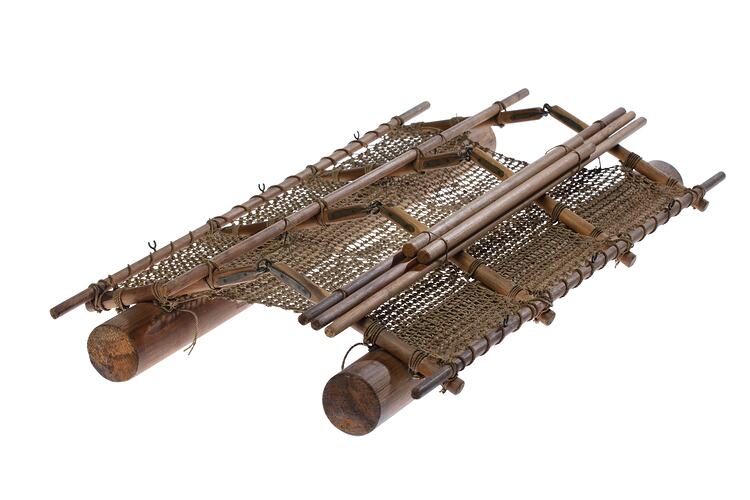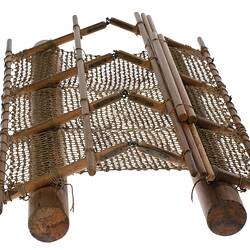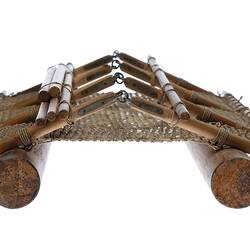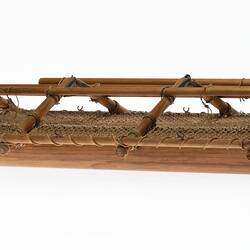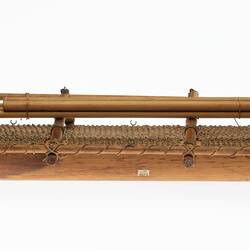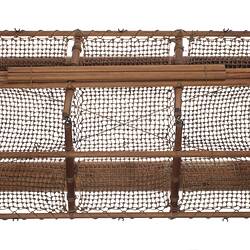Summary
Model of a Melbourne invention made of wood and twine with two cylindrical floats attached to a spar framework, supporting a netting platform and a folding mast. Invented by John Turnbull of Melbourne and displayed at the Melbourne Intercolonial Exhibition of 1875.
A four page document originally tied to the model reads:
'The Queen' Life Raft. Which can be rowed or sailed and can carry 40 persons in perfect safety. The Craft consists of a spar framework and (?) rope lashed with 2 1/2 inch rope net platform carried on 2 cylinders 2 feet 2 inches diameter and 24 feet long each divided into 6 airtight compartments the structure being all yielding is capable of bearing great fatigue. It can be hoisted and lowered from any ordinary boat davits and requires no more space for stowage than an ordinary boat of equal length and can be swung inboard with equal facility. The advantages claimed for it are: Its portability from the folding principle/ Its power of flotation: Its capability of enduring rough usage: Its fitness to be propelled by oars or sailed even on a wind if not too heavily laden. The model illustrates form and arrangement. Scale 1 foot to 1 inch.
Construction of the Raft: 2 cylinders of copper 32nd inch thick 2 feet in diameter 24 feet long divided into 6 airtight compartments covered with painted canvas and protected by 5/8 inch pine plank hooped on like a cask. 4 transverse beams hinged at mid length secured to the cylinders by lashing through 2 eyes forged on each of the 4 principal hoops of each cylinder. The rings in the hinges of these beams serve for hooking on the davit tackles/ 4 long spars lashed across the beams at equal intervals/ Strong rope nets are laced to the outside spars forming the platform for load etc. (?). After launching these nets should be triced up to all the spar for more perfect support. 2 stong diagonal braces are provided under the net. 2 girting (?) pennants also to prevent depression of the middle in launching until the splicing bars are secured in position when the pennants shoudl be removed. Mast sails and oars are provided with rowlocks which should be carried in cleats secured to the outer sails. Convenient packages of food and water can be secured to the mid-ships of the net and remain in position when the raft is hung at the davits so as to be ever ready. John Turnbull No 1 Queen St.'
This document is hand-written on legal paper that was originally blue (it is much discoloured in 2005) and tied with red legal tape. Formerly numbered 8926. Its Intercolonial Exhibition number was 2697A.
More Information
-
Collecting Areas
-
Acquisition Information
Donation from J. Turnbull, Exhibition: 1875 Intercolonial, Melbourne
-
Place & Date Used
-
Classification
-
Category
-
Discipline
-
Type of item
-
Overall Dimensions
710 mm (Length), 230 mm (Width), 370 mm (Height)
-
Model Scale
1:12
-
Keywords
Exhibitions: Melbourne Intercolonial, Victorian, 1875, Model Rafts, Rafts, Scale Models, Water Transport, Innovation & Design
